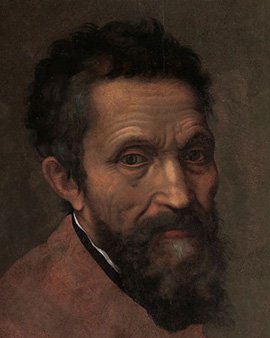The detail of Adam's creation from the ceiling painting of the Sistine Chapel or the marble statue of David, which is a real attraction in the Louvre in Paris, are probably among the most famous works of the exceptional artist Michelangelo Buonarroti, who is often only mentioned by his first name Michelangelo. He counts among the most important artists of the Italian High Renaissance.
Born on 6 March 1475 in Tuscany, young Michelangelo did not always have an easy life. He came from an influential middle-class family who moved to Florence only shortly after his birth. The talented Michelangelo knew early on what he wanted: to become an artist - even against his father's will. So he became a paid student of the painter Domenico Ghirlandino and also attended the art school of Lorenzo di Medici. Although the young artist was initially occupied with painting, he was always more inclined towards sculpture. At the age of twenty Michelangelo went to Bologna, where he made statues of angels and saints, but after only one year he returned to Florence. In Florence, and also during his stays in Rome, Michelangelo produced numerous sculptures, including the Pietà of St. Peter, commissioned by the Abbot of St. Denis and Cardinal Priest of Santa Sabina, which can still be seen in St. Peter's Basilica in the Vatican.
After his second return to Florence the imposing statue of David was created. It was hewn from a huge marble block on which an artist had already tried unsuccessfully 40 years earlier and the block has been lying around uselessly ever since. The free and at the same time precise execution created the imposing, powerful, triumphant representation of David, which was admired and appreciated by the most respected artists even then.
Although, it seems, Michelangelo increasingly devoted himself to sculpture and numerous imposing statues emerged from it, the Italian did not let the brush rest. Nevertheless, during his third stay in Rome, the artist was literally urged to accept the commission for the ceiling painting of the Sistine Chapel. The project that was forced upon him is one of Michelangelo's most important and best-known masterpieces. It shows the many hundreds of figures from the creation of mankind to the Flood. The original commission by the Pope included only the twelve apostles. However, Michelangelo found this too meagre and so he expanded his designs. After four long years of laborious and exhausting work, the work was completed. Michelangelo always changed his residence between Florence and Rome, where he produced numerous other paintings, sculptures and well-known funerary monuments such as the Julius monument. In the course of his life, the master produced numerous plans and designs for works and projects, some of which took on gigantic proportions. But in the end, only a fraction of these were actually produced, so that Michelangelo always had the problem of the "non-finito". Michelangelo found his last resting place in Rome on 18 February 1564.
×





.jpg)
.jpg)
.jpg)
.jpg)
.jpg)
.jpg)
.jpg)
.jpg)
 The Creation of Adam 1511-12 (post restoration) - (MeisterDrucke-107511).jpg)
 The Creation of Adam 1511-12 (post restoration) - (MeisterDrucke-107511).jpg)
.jpg)
.jpg)
.jpg)
.jpg)
.jpg)
.jpg)
.jpg)
.jpg)
 - (MeisterDrucke-110184).jpg)
 - (MeisterDrucke-110184).jpg)
.jpg)
.jpg)
 - (MeisterDrucke-249603).jpg)
 - (MeisterDrucke-249603).jpg)
.jpg)
.jpg)
_-_(MeisterDrucke-263112).jpg)
_-_(MeisterDrucke-263112).jpg)
.jpg)
.jpg)
 - (MeisterDrucke-116413).jpg)
 - (MeisterDrucke-116413).jpg)
.jpg)
.jpg)
 - (MeisterDrucke-43665).jpg)
 - (MeisterDrucke-43665).jpg)
.jpg)
.jpg)
_Creation_of_Adam_-_(MeisterDrucke-926762).jpg)
_Creation_of_Adam_-_(MeisterDrucke-926762).jpg)
.jpg)
.jpg)
_drawing_Paris_Louvre_M_-_(MeisterDrucke-636260).jpg)
_drawing_Paris_Louvre_M_-_(MeisterDrucke-636260).jpg)
.jpg)
.jpg)
 (see also 73704) - (MeisterDrucke-204075).jpg)
 (see also 73704) - (MeisterDrucke-204075).jpg)
.jpg)
.jpg)
.jpg)
.jpg)
.jpg)
.jpg)
 c1510-11 (red chalk on paper) - (MeisterDrucke-128139).jpg)
 c1510-11 (red chalk on paper) - (MeisterDrucke-128139).jpg)
.jpg)
.jpg)
 - (MeisterDrucke-84503).jpg)
 - (MeisterDrucke-84503).jpg)
 - (MeisterDrucke-301451).jpg)
 - (MeisterDrucke-301451).jpg)
.jpg)
.jpg)
.jpg)
.jpg)
 - (MeisterDrucke-84360).jpg)
 - (MeisterDrucke-84360).jpg)
_1509_by_Michelan_-_(MeisterDrucke-378118).jpg)
_1509_by_Michelan_-_(MeisterDrucke-378118).jpg)
.jpg)
.jpg)
.jpg)
.jpg)
_-_(MeisterDrucke-38707).jpg)
_-_(MeisterDrucke-38707).jpg)
.jpg)
.jpg)
 - (MeisterDrucke-72100).jpg)
 - (MeisterDrucke-72100).jpg)
 - (MeisterDrucke-39817).jpg)
 - (MeisterDrucke-39817).jpg)
.jpg)
.jpg)
.jpg)
.jpg)
.jpg)
.jpg)
.jpg)
.jpg)
_-_(MeisterDrucke-1664598).jpg)
_-_(MeisterDrucke-1664598).jpg)
 Design for a tomb (red chalk) - (MeisterDrucke-76248).jpg)
 Design for a tomb (red chalk) - (MeisterDrucke-76248).jpg)
 - (MeisterDrucke-187458).jpg)
 - (MeisterDrucke-187458).jpg)
.jpg)
.jpg)
.jpg)
.jpg)
.jpg)
.jpg)
.jpg)
.jpg)
.jpg)
.jpg)
.jpg)
.jpg)
.jpg)
.jpg)
.jpg)
.jpg)
 - (MeisterDrucke-51515).jpg)
 - (MeisterDrucke-51515).jpg)
.jpg)
.jpg)
.jpg)
.jpg)
.jpg)
.jpg)
.jpg)
.jpg)
_-_(MeisterDrucke-190148).jpg)
_-_(MeisterDrucke-190148).jpg)
 - (MeisterDrucke-54391).jpg)
 - (MeisterDrucke-54391).jpg)
_(marble)_-_(MeisterDrucke-315792).jpg)
_(marble)_-_(MeisterDrucke-315792).jpg)
.jpg)
.jpg)
.jpg)
.jpg)
.jpg)
.jpg)
 - (MeisterDrucke-62972).jpg)
 - (MeisterDrucke-62972).jpg)
.jpg)
.jpg)
.jpg)
.jpg)
_-_(MeisterDrucke-1663964).jpg)
_-_(MeisterDrucke-1663964).jpg)
.jpg)
.jpg)
.jpg)
.jpg)
.jpg)
.jpg)
 - (MeisterDrucke-270611).jpg)
 - (MeisterDrucke-270611).jpg)
.jpg)
.jpg)
 - (MeisterDrucke-193529).jpg)
 - (MeisterDrucke-193529).jpg)
 1520-34 (marble) - (MeisterDrucke-298650).jpg)
 1520-34 (marble) - (MeisterDrucke-298650).jpg)
.jpg)
.jpg)
 - (MeisterDrucke-553361).jpg)
 - (MeisterDrucke-553361).jpg)
.jpg)
.jpg)
 - (MeisterDrucke-43677).jpg)
 - (MeisterDrucke-43677).jpg)
.jpg)
.jpg)
.jpg)
.jpg)
.jpg)
.jpg)
 (recto) (for verso see 192511) - (MeisterDrucke-63894).jpg)
 (recto) (for verso see 192511) - (MeisterDrucke-63894).jpg)
_-_(MeisterDrucke-264108).jpg)
_-_(MeisterDrucke-264108).jpg)
 - (MeisterDrucke-106384).jpg)
 - (MeisterDrucke-106384).jpg)
_-_(MeisterDrucke-1664495).jpg)
_-_(MeisterDrucke-1664495).jpg)
_detail_sculpture_in_-_(MeisterDrucke-1058085).jpg)
_detail_sculpture_in_-_(MeisterDrucke-1058085).jpg)
 - (MeisterDrucke-168259).jpg)
 - (MeisterDrucke-168259).jpg)
 - (MeisterDrucke-176284).jpg)
 - (MeisterDrucke-176284).jpg)
 - (MeisterDrucke-241482).jpg)
 - (MeisterDrucke-241482).jpg)
 - (MeisterDrucke-262056).jpg)
 - (MeisterDrucke-262056).jpg)
.jpg)
.jpg)
 - (MeisterDrucke-568819).jpg)
 - (MeisterDrucke-568819).jpg)
 - (MeisterDrucke-173538).jpg)
 - (MeisterDrucke-173538).jpg)
.jpg)
.jpg)
.jpg)
.jpg)
.jpg)
.jpg)






